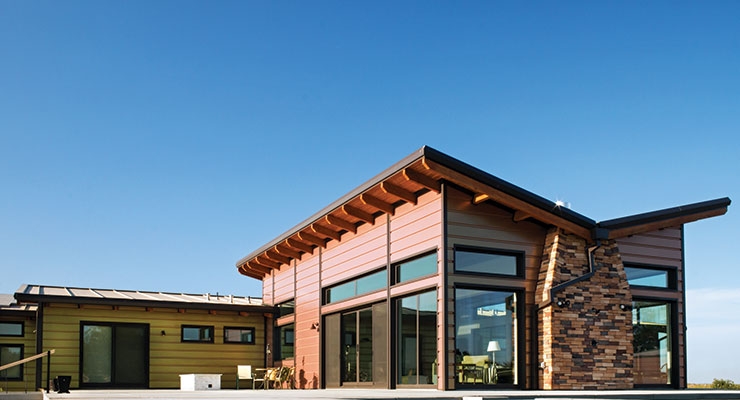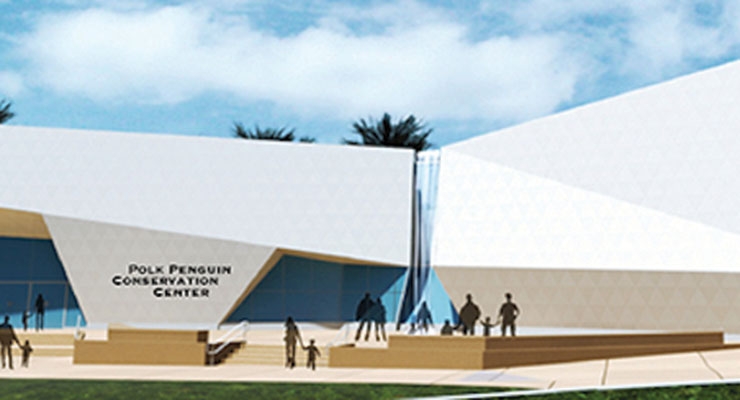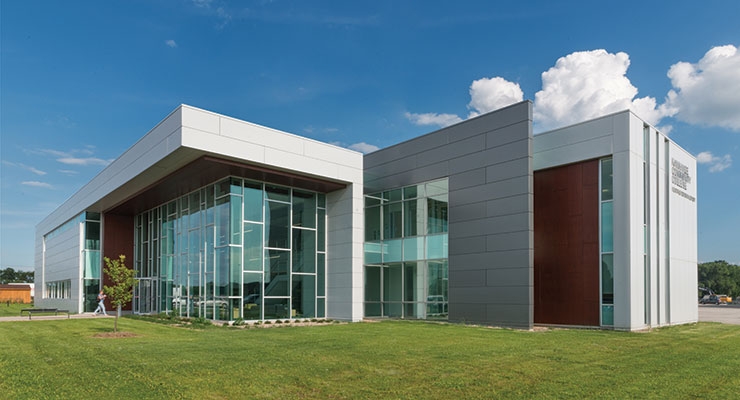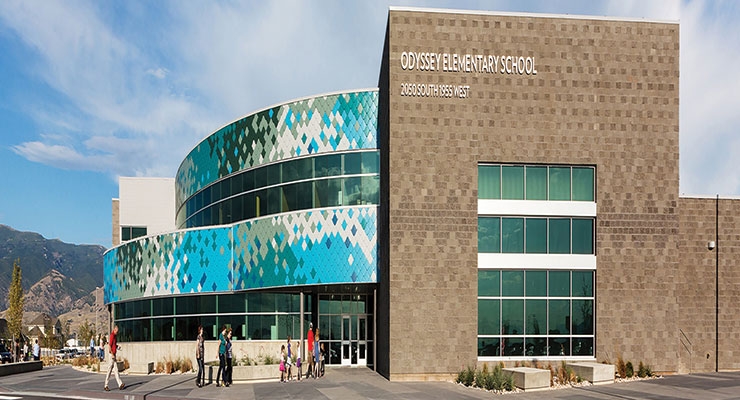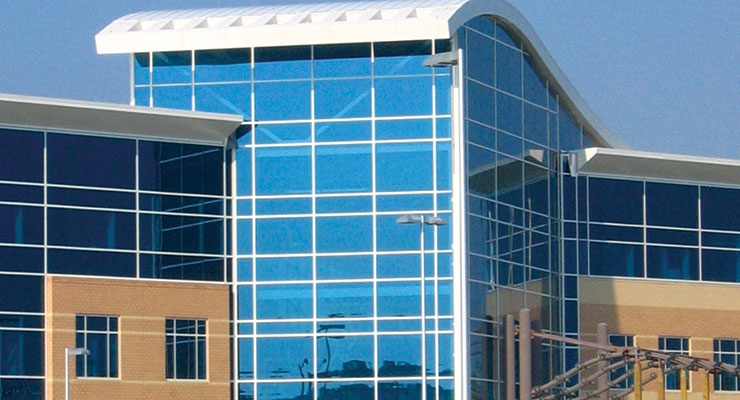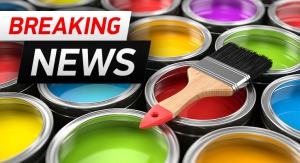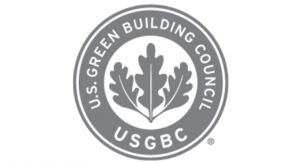Jeff Alexander, VP of Sales, coil and extrusion division, Valspar11.09.16
Sustainability is currently one of the most discussed subject matters in our industry, yet arguably one of the least understood. The never-ending interpretations of the word tend to fog the actual meaning, leaving many confused on what achieving sustainability truly looks like.
The attention given to this topic, spanning both back-end developers like, architects and coating manufacturers, and front-end users like building owners and tenants, has not gone unnoticed.
According to the U.S. Environment Protection Agency and the U.S. Green Building Council, construction and operation of all buildings in the United States results in the consumption of 72 percent of electricity resources, 29 percent of total energy used, 30 percent of CO2 production and a 12 degrees increase in urban areas due to heat island effect. These are significant numbers that we can all agree should be lowered, and we as a whole are coming together to make the change across all spaces of construction and design.
Given the extent to which buildings affect the environment, it is important that coating manufacturers set an example and continue to produce more sustainable products and technologies. Let’s take a look at a few different sectors within the industry to see how each is utilizing sustainable materials and what it can mean for architectural development as a whole.
Sustainability in Education
Education is what feeds advancement and progress for our future, providing the foundation that young people across the country need in order to flourish in their professional and personal lives. Educational facilities and environments provide these formative experiences and have an influence on all who participate within them.
The focus on sustainability has made its way into the education division as schools across the country are aging, becoming outdated and going through renovations, or simply being rebuilt. During this process, those at the forefront are looking for ways that their schools can better serve local student bodies with a more sustainable approach. Some environmentally and resource-friendly features that educational facilities are implementing include natural lighting, the use of reusable or recycled materials, and metal wall and roof panels to improve energy efficiency.
Specifically for metal roof panels, sustainable coating formulations have been improved to increase building resistance to the negative effects of ultraviolet rays and provide dirt and stain prevention, which can increase the lifespan of a building.
A great example of this focus on sustainability can be seen in the expansions of the Odyssey Elementary School and Kankakee Community College.
Odyssey Elementary School was one of two schools in the Davis School District in Farmington, Utah that underwent a much-needed educational expansion. The new plan called for 84,785 square-feet of environmentally-conscious constructions that would help the school obtain LEED Gold certification. Through its use of 1,200 solar panels, natural lighting, and metal shingles finished in a coating with superior resistance to ultraviolet rays, the school did just that. Odyssey Elementary School opened its doors in 2014 and is one of the greenest schools in Utah.
Similarly, in order to better serve a growing classroom size and demand for a wider range of academic offerings, the Kankakee Community College system made plans to create satellite campuses outside of Kankakee, including the North Extension in Bradley, Illinois. With a goal to meet the U.S. Green Building Council’s LEED Silver standard or higher, the design team installed many energy-focused features, including insulated metal wall panels that provide superior thermal efficiency to the facility. The community college opened July 2014, and became the first building in Kankakee County to receive U.S. Green Building Council’s LEED Gold certification.
Sustainability in Health Care
The health care industry pursues to protect, restore and enhance public health. As a result, it is important for health care organizations to adopt an approach to design, construct and maintain facilities that support healthy environments for their patients and surrounding communities. This is where our industry can help, as the use of sustainable materials can drastically enhance a building’s overall health.
The Jackson Laboratory for Genomic Medicine in Connecticut placed a focus on sustainable design measures when undergoing its restructure. The laboratory focused on energy efficiency, indoor environmental quality (IEQ), and site conservation. They also used metal panels finished in a durable coating that provides the exterior with added protection and will extend the life of the building. The use of metal panels helped further the building’s sustainability goals as the metal material itself is made of recycled products. The coating applied then helps to protect the panels, conserving the product and ensuring that they will not need to be replaced in a few years, consequently requiring the use of additional building materials.
As an extension to the Children’s Hospital of The King’s Daughters and part of the Sentara Princess Anne Medical campus, the Princess Anne Office Building was constructed in 2008 to provide medical offices, an outpatient surgery center, laboratories, and a radiology suite to support the organization’s growing needs. Due to the building’s proximity to the Atlantic ocean, the Princess Anne Office Building was designed with an ocean-themed motif that extends all the way to its sloping metal roof that was constructed to emulate the cresting ocean. The metal roof was finished in a protective solar reflective coating that enhances the energy-efficiency of the building, in turn helping to lower cooling costs and conserve resources.
Sustainability in Public Buildings
The year 2015 was documented as the warmest in record. In total, the 10 hottest years in history have all occurred since 1998. The efforts of reducing energy use and carbon emissions are crucial to managing this shift. In public buildings, especially located in compact urban areas, a growing issue occurs when additional energy is used for cooling because this usage adds to the problem of urban heat island effect. Urban heat island effect refers to the risk of increased temperatures in urban areas relative to the surrounding rural or natural areas due to the high concentration of heat-absorbing surfaces. For example, temperatures in urban areas have increased up to 12 degrees above the normal temperature in nearby rural areas.
A main contributor to this issue also comes from the fact that at least 20 percent of the land surface in most urban areas is covered by roofing, and traditional roofing materials absorb 85 to 95 percent of the sun’s heat energy. As part of the solution, the need for more products that reduce the amount of energy we consume and place more emphasis on their environmental effects has grown. The global green coatings market has seen an increase in demand in recent years and is forecasted to grow 5.1 percent annually through 2020.
The coatings industry has seen a similar need for helping to solve the urban heat island effect and has worked to formulate coatings with the highest Solar Reflective (SR) values to develop a solution. Solar reflective coatings are formulated to reflect the sun’s infrared energy, which in turn reduces the amount of infrared light absorbed by an exterior surface. In consequence, this helps to combat the urban heat island effect and can result in lower energy consumption for a building, and in turn a city.
For example, the Polk Penguin Conservation Center in the Detroit Zoo utilized solar reflective coatings to help achieve a resembled look of an Antarctic iceberg. With the goal to reflect a penguin’s natural icy habitat, the manufacturers installed diamond-shaped metal panels and applied a unique solar reflective pearlescent coating, providing the penguin center with a beautiful and energy-saving exterior. The coating contains 70 percent PVDF resins and resulted in outstanding protection against dirt and staining as well as exceptional color consistency and retention.
Sustainability in Residential
Beyond business’s efforts toward achieving a more sustainable environment, home owners are also undertaking green building practices due to the obvious benefits of better durability, energy and water savings and improved indoor air quality. These benefits then act as a butterfly effect, eliminating the potential for mold, minimizing VOC emissions and extending the life of home structure.
One homeowner living in the California countryside was looking to both downsize as well as create a truly sustainable home.
Driven by these two goals, the owner designed and constructed a net-zero metal home, using efficient technologies like solar panels and geothermal heating and cooling throughout the house. He also chose insulated panels for the walls and roof, which provided an R-value (the capacity of an insulated material to resist heat flow) of 42 – well exceeding California’s building standards. In addition, a solar reflective coating was applied to the metal roof, further contributing to the home’s energy efficiency.
The coating also helps with the longevity of the home’s appearance, as it’s resistant to humidity, fading, chalking, abrasions and most chemicals.
Metal roofs are one sustainable practice making its way from the commercial realm into residential spaces. Alone, the use of a metal roof can contribute to a more sustainable building, but when finished in a coating that contains solar reflective pigments, the benefits are multiplied. Solar-reflective pigments help lower the overall temperature of structures while providing exceptional durability and reducing both energy consumption and your environmental footprint. Recently, an Indiana resident set out to build a new home. From the beginning, he was set on using a metal roof because he knew it would be a smart investment that requires minimal maintenance and provides durability. To further safeguard his metal roof, he chose to finish the material in a coating that would provide protection against harmful UV rays for years to come, benefiting the entire home.
The Future in Sustainable Coating
North America leads the world in the demand for green building materials - accounting for 40 percent of the total market share - and that demand is reflected throughout the coating industry as well.
Innovations continue to move sustainable coatings from passive to active performance and from minimizing damage to repairing and restoring resources. These advances will only continue to improve as coating manufacturers take sustainability goals to heart, making enhancements that will deliver products that not only meet these stringent environmental demands, but also exceed them.
The attention given to this topic, spanning both back-end developers like, architects and coating manufacturers, and front-end users like building owners and tenants, has not gone unnoticed.
According to the U.S. Environment Protection Agency and the U.S. Green Building Council, construction and operation of all buildings in the United States results in the consumption of 72 percent of electricity resources, 29 percent of total energy used, 30 percent of CO2 production and a 12 degrees increase in urban areas due to heat island effect. These are significant numbers that we can all agree should be lowered, and we as a whole are coming together to make the change across all spaces of construction and design.
Given the extent to which buildings affect the environment, it is important that coating manufacturers set an example and continue to produce more sustainable products and technologies. Let’s take a look at a few different sectors within the industry to see how each is utilizing sustainable materials and what it can mean for architectural development as a whole.
Sustainability in Education
Education is what feeds advancement and progress for our future, providing the foundation that young people across the country need in order to flourish in their professional and personal lives. Educational facilities and environments provide these formative experiences and have an influence on all who participate within them.
The focus on sustainability has made its way into the education division as schools across the country are aging, becoming outdated and going through renovations, or simply being rebuilt. During this process, those at the forefront are looking for ways that their schools can better serve local student bodies with a more sustainable approach. Some environmentally and resource-friendly features that educational facilities are implementing include natural lighting, the use of reusable or recycled materials, and metal wall and roof panels to improve energy efficiency.
Specifically for metal roof panels, sustainable coating formulations have been improved to increase building resistance to the negative effects of ultraviolet rays and provide dirt and stain prevention, which can increase the lifespan of a building.
A great example of this focus on sustainability can be seen in the expansions of the Odyssey Elementary School and Kankakee Community College.
Odyssey Elementary School was one of two schools in the Davis School District in Farmington, Utah that underwent a much-needed educational expansion. The new plan called for 84,785 square-feet of environmentally-conscious constructions that would help the school obtain LEED Gold certification. Through its use of 1,200 solar panels, natural lighting, and metal shingles finished in a coating with superior resistance to ultraviolet rays, the school did just that. Odyssey Elementary School opened its doors in 2014 and is one of the greenest schools in Utah.
Similarly, in order to better serve a growing classroom size and demand for a wider range of academic offerings, the Kankakee Community College system made plans to create satellite campuses outside of Kankakee, including the North Extension in Bradley, Illinois. With a goal to meet the U.S. Green Building Council’s LEED Silver standard or higher, the design team installed many energy-focused features, including insulated metal wall panels that provide superior thermal efficiency to the facility. The community college opened July 2014, and became the first building in Kankakee County to receive U.S. Green Building Council’s LEED Gold certification.
Sustainability in Health Care
The health care industry pursues to protect, restore and enhance public health. As a result, it is important for health care organizations to adopt an approach to design, construct and maintain facilities that support healthy environments for their patients and surrounding communities. This is where our industry can help, as the use of sustainable materials can drastically enhance a building’s overall health.
The Jackson Laboratory for Genomic Medicine in Connecticut placed a focus on sustainable design measures when undergoing its restructure. The laboratory focused on energy efficiency, indoor environmental quality (IEQ), and site conservation. They also used metal panels finished in a durable coating that provides the exterior with added protection and will extend the life of the building. The use of metal panels helped further the building’s sustainability goals as the metal material itself is made of recycled products. The coating applied then helps to protect the panels, conserving the product and ensuring that they will not need to be replaced in a few years, consequently requiring the use of additional building materials.
As an extension to the Children’s Hospital of The King’s Daughters and part of the Sentara Princess Anne Medical campus, the Princess Anne Office Building was constructed in 2008 to provide medical offices, an outpatient surgery center, laboratories, and a radiology suite to support the organization’s growing needs. Due to the building’s proximity to the Atlantic ocean, the Princess Anne Office Building was designed with an ocean-themed motif that extends all the way to its sloping metal roof that was constructed to emulate the cresting ocean. The metal roof was finished in a protective solar reflective coating that enhances the energy-efficiency of the building, in turn helping to lower cooling costs and conserve resources.
Sustainability in Public Buildings
The year 2015 was documented as the warmest in record. In total, the 10 hottest years in history have all occurred since 1998. The efforts of reducing energy use and carbon emissions are crucial to managing this shift. In public buildings, especially located in compact urban areas, a growing issue occurs when additional energy is used for cooling because this usage adds to the problem of urban heat island effect. Urban heat island effect refers to the risk of increased temperatures in urban areas relative to the surrounding rural or natural areas due to the high concentration of heat-absorbing surfaces. For example, temperatures in urban areas have increased up to 12 degrees above the normal temperature in nearby rural areas.
A main contributor to this issue also comes from the fact that at least 20 percent of the land surface in most urban areas is covered by roofing, and traditional roofing materials absorb 85 to 95 percent of the sun’s heat energy. As part of the solution, the need for more products that reduce the amount of energy we consume and place more emphasis on their environmental effects has grown. The global green coatings market has seen an increase in demand in recent years and is forecasted to grow 5.1 percent annually through 2020.
The coatings industry has seen a similar need for helping to solve the urban heat island effect and has worked to formulate coatings with the highest Solar Reflective (SR) values to develop a solution. Solar reflective coatings are formulated to reflect the sun’s infrared energy, which in turn reduces the amount of infrared light absorbed by an exterior surface. In consequence, this helps to combat the urban heat island effect and can result in lower energy consumption for a building, and in turn a city.
For example, the Polk Penguin Conservation Center in the Detroit Zoo utilized solar reflective coatings to help achieve a resembled look of an Antarctic iceberg. With the goal to reflect a penguin’s natural icy habitat, the manufacturers installed diamond-shaped metal panels and applied a unique solar reflective pearlescent coating, providing the penguin center with a beautiful and energy-saving exterior. The coating contains 70 percent PVDF resins and resulted in outstanding protection against dirt and staining as well as exceptional color consistency and retention.
Sustainability in Residential
Beyond business’s efforts toward achieving a more sustainable environment, home owners are also undertaking green building practices due to the obvious benefits of better durability, energy and water savings and improved indoor air quality. These benefits then act as a butterfly effect, eliminating the potential for mold, minimizing VOC emissions and extending the life of home structure.
One homeowner living in the California countryside was looking to both downsize as well as create a truly sustainable home.
Driven by these two goals, the owner designed and constructed a net-zero metal home, using efficient technologies like solar panels and geothermal heating and cooling throughout the house. He also chose insulated panels for the walls and roof, which provided an R-value (the capacity of an insulated material to resist heat flow) of 42 – well exceeding California’s building standards. In addition, a solar reflective coating was applied to the metal roof, further contributing to the home’s energy efficiency.
The coating also helps with the longevity of the home’s appearance, as it’s resistant to humidity, fading, chalking, abrasions and most chemicals.
Metal roofs are one sustainable practice making its way from the commercial realm into residential spaces. Alone, the use of a metal roof can contribute to a more sustainable building, but when finished in a coating that contains solar reflective pigments, the benefits are multiplied. Solar-reflective pigments help lower the overall temperature of structures while providing exceptional durability and reducing both energy consumption and your environmental footprint. Recently, an Indiana resident set out to build a new home. From the beginning, he was set on using a metal roof because he knew it would be a smart investment that requires minimal maintenance and provides durability. To further safeguard his metal roof, he chose to finish the material in a coating that would provide protection against harmful UV rays for years to come, benefiting the entire home.
The Future in Sustainable Coating
North America leads the world in the demand for green building materials - accounting for 40 percent of the total market share - and that demand is reflected throughout the coating industry as well.
Innovations continue to move sustainable coatings from passive to active performance and from minimizing damage to repairing and restoring resources. These advances will only continue to improve as coating manufacturers take sustainability goals to heart, making enhancements that will deliver products that not only meet these stringent environmental demands, but also exceed them.

